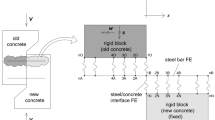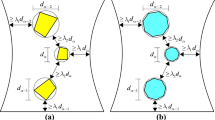Abstract
In this paper, we study a mixed-mode fracture process using a conventional two dimensional lattice model with incorporated meso-level internal material structure. Simple elasto-brittle elements of the network are divided into three phases according to a projected grain layout. The stiffness of any element that fulfils a failure criterion is removed. As a new feature of the otherwise standard lattice approach, we added the recovery of normal stiffness when a severed element enters the compressive regime. This enhancement enables capture of the shear resistance of an existing crack caused by crack roughness, i.e. what is termed aggregate interlocking. We demonstrate this enhancement via the simulation of mixed-mode experiments on concrete performed at a laboratory at the Technical University of Denmark. Double notched concrete specimens were initially pre-cracked in tension. Then, various combinations of tensile and shear load (normal and tangential to the crack plane) were applied. Simulated crack patterns and load–displacement curves are compared to the experimental observations.
Similar content being viewed by others
References
Abreu MM, Lemos JV, Carmeliet J, Schlangen E (2007) Modelling compressive cracking in concrete using a modified lattice model. In: Carpinteri A, Gambarova PG, Ferro G, Plizzari G (eds) Fracture mechanics of concrete and concrete structures—new trends in fracture mechanics of concrete. Taylor & Francis Group, London
Asahina D, Landis E, Bolander J (2011) Modeling of phase interfaces during pre-critical crack growth in concrete. Cem ConcrCompos 33(9):966–977 doi:10.1016/j.cemconcomp.2011.01.007
Barber CB, Dobkin DP, Huhdanpaa H (1996) The quickhull algorithm for convex hulls. ACM T Math Softw 22(4): 469–483. doi:10.1.1.54.6345
Beranek WJ, Hobbelman GJ (1995) 2D and 3D-modelling of concrete as an assemblage of spheres, revaluation of the failure criterion. In: Wittmann FH (ed) Fracture mechanics of concrete structures, Aedificatio Publishers, Freiburg, pp 965–978
Bolander JE, Kobashi Y (1995) Size effect mechanisms in numerical concrete fracture. In: Wittmann FH (ed) Fracture mechanics of concrete structures, Aedificatio Publishers, Freiburg, pp 535–542
Bolander JE, Saito S (1998) Fracture analyses using spring networks with random geometry. Eng Fract Mech 61(5-6): 569–591. doi:10.1016/S0013-7944(98)00069-1
Bolander JE, Hikosaka H, He WJ (1998) Fracture in concrete specimens of different scale. Eng Comput 15(8): 1094–1116. doi:10.1108/02644409810244156
Bolander JE, Hong GS, Yoshitake K (2000) Structural concrete analysis using rigid-body-spring networks. Comput-Aided Civ Inf 15: 120–133. doi:10.1111/0885-9507.00177
Cusatis G, Cedolin L (2007) Two-scale study of concrete fracturing behavior. Eng Fract Mech 74(1-2): 3–17. doi:10.1016/j.engfracmech.2006.01.021
Cusatis G, Bažant ZP, Cedolin L (2006) Confinement-shear lattice CSL model for fracture propagation in concrete. Comput Methods Appl Mech Eng 195(52): 7154–7171. doi:10.1016/j.cma.2005.04.019
DeJong MJ, Hendriks MA, Rots JG (2008) Sequentially linear analysis of fracture under non-proportional loading. Eng Fract Mech 75(18): 5042–5056. doi:10.1016/j.engfracmech.2008.07.003
Eliáš J, Frantík P, Vořechovský M (2010) Improved sequentially linear solution procedure. Eng Fract Mech 77(12): 2263–2276. doi:10.1016/j.engfracmech.2010.05.018
Eliáš J, Vořechovský M (2012) The effect of mesh density in lattice models for concrete with incorporated mesostructure. Key Eng Mat 488-489(12): 29–32. doi:10.4028/www.scientific.net/KEM.488-489.29
Hassanzadeh M (1991) Behavior of fracture process zones in concrete influenced by simultaneously applied normal and shear displacements. Ph.D. thesis, Division of Building Materials, Lund Institute of Technology, Lund, Sweden
Herrmann HJ, Hansen A, Roux S (1989) Fracture of disordered, elastic lattices in two dimensions. Phys Rev B 39(1): 637–648. doi:10.1103/PhysRevB.39.637
Ince R, Arslan A, Karihaloo BL (2003) Lattice modelling of size effect in concrete strength. Eng Fract Mech 70(16): 2307–2320. doi:10.1016/S0013-7944(02)00219-9
Jirásek M, Bažant ZP (1994) Macroscopic fracture characteristics of random particle systems. Int J Fract 69: 201–228. doi:10.1007/BF00034763
Jirásek M, Bažant ZP (1995) Particle model for quasibrittle fracture and application to sea ice. J Eng Mech-ASCE 121 (9):1016–1025. doi:http://dx.doi.org/10.1061/(ASCE)0733-9399(1995)121:9(1016)
Kawai T (1978) New discrete models and their application to seismic response analysis of structures. Nucl Eng Des 48(1): 207–229. doi:10.1016/0029-5493(78)90217-0
Kozicki J, Tejchman J (2006) 2D lattice model for fracture in brittle materials. Arch Hydro-Eng Environ Mech 53(2): 137–154
Leite JPB, Slowik V, Mihashi H (2004) Computer simulation of fracture processes of concrete using mesolevel models of lattice structures. Cem Concr Res 34(6): 1025–1033. doi:10.1016/j.cemconres.2003.11.011
Lilliu G, van Mier JGM (2003) 3D lattice type fracture model for concrete. Eng Fract Mech 70(7-8): 927–941. doi:10.1016/S0013-7944(02)00158-3
Lilliu G, van Mier JGM (2007) On the relative use of micro-mechanical lattice analysis of 3-phase particle composites. Eng Fract Mech 74(7): 1174–1189. doi:10.1016/j.engfracmech.2006.12.018
Man HK, van Mier JGM (2008a) Influence of particle density on 3D size effects in the fracture of (numerical) concrete. Mech Mater 40(6): 470–486. doi:10.1016/j.mechmat.2007.11.003
Man HK, van Mier JGM (2008b) Size effect on strength and fracture energy for numerical concrete with realistic aggregate shapes. Int J Fract 154(1-2): 61–72. doi:10.1007/s10704-008-9270-y
Man HK, van Mier JGM (2011) Damage distribution and size effect in numerical concrete from lattice analyses. Cem Concr Compos 33(9): 867–880. doi:10.1016/j.cemconcomp.2011.01.008
Nooru-Mohamed MB (1992) Mixed-mode fracture of concrete: an experimental approach. Ph.D. thesis, Delft University of Technology, Delft, The Netherlands
Nooru-Mohamed MB, Shlangen E, van Mier JGM (1993) Experimental and numerical study on the behavior of concrete subjected to biaxial tension and shear. Adv Cem Based Mater 1(1): 22–37. doi:10.1016/1065-7355(93)90005-9
Østergaard L, Olesen JF, Poulsen PN (2007) Biaxial testing machine for mixed mode cracking of concrete. In: Carpinteri A, Gambarova PG, Ferro G, Plizzari G (eds) Fracture mechanics of concrete and concrete structures—new trends in fracture mechanics of concrete. Taylor & Francis Group, London, pp 263–270
Ostoja-Starzewski M, Sheng PY, Jasiuk I (1997) Damage patterns and constitutive response of random matrix-inclusion composites. Eng Fract Mech 58(5–6): 581–606. doi:10.1016/S0013-7944(97)00046-5
Petersen RB (2008) Fracture mechanical analysis of reinforced concrete-experiments and FEM modelling. Master’s thesis, Department of Civil Engineering, Technical University of Denmark, Anker Engelundsvej 1, 2800 Kgs. Lyngby, Denmark
Prado EP, van Mier JGM (2003) Effect of particle structure on mode I fracture process in concrete. Eng Fract Mech 70(14): 1793–1807. doi:10.1016/S0013-7944(03)00125-5
Rots JG, Belletti B, Invernizzi S (2008) Robust modeling of RC structures with an “event-by-event” strategy. Eng Fract Mech 75(3–4): 590–614. doi:10.1016/j.engfracmech.2007.03.027
Roux S, Guyon E (1985) Mechanical percolation: a small beam lattice study. J Phys Lett-Paris 46(21): 999–1004. doi:10.1051/jphyslet:019850046021099900
Sagar RV, Prasad BKR, Karihaloo BL (2010) Verification of the applicability of lattice model to concrete fracture by AE study. Int J Fract 161(2): 121–129. doi:10.1007/s10704-009-9431-7
Schlangen E (1993) Experimental and numerical analysis of fracture processes in concrete. Ph.D. thesis, Delft University of Technology, Netherlands
Schlangen E, Garboczi EJ (1997) Fracture simulations of concrete using lattice models: Computational aspects. Eng Fract Mech 57(2–3): 319–332. doi:10.1016/S0013-7944(97)00010-6
Schlangen E, Koenders E, van Breugel K (2007) Influence of internal dilation on the fracture behaviour of multi-phase materials. Eng Fract Mech 74(1-2): 18–33. doi:10.1016/j.engfracmech.2006.01.033
Skoček J, Stang H (2010) Application of optical deformation analysis system on wedge splitting test and its inverse analysis. Mater Struct 43(1): 63–72. doi:10.1617/s11527-010-9597-5
van Mier JGM, van Vliet MRA (2003) Influence of microstructure of concrete on size/scale effects in tensile fracture. Eng Fract Mech 70(16): 2281–2306. doi:10.1016/S0013-7944(02)00222-9
van Mier JGM, Chiaia BM, Vervuurt A (1997) Numerical simulation of chaotic and self-organizing damage in brittle disordered materials. Comput Method Appl Mech Eng 142(1-2): 189–201. doi:10.1016/S0045-7825(96)01128-0
van Mier JGM, van Vliet MRA, Wang TK (2002) Fracture mechanisms in particle composites: statistical aspects in lattice type analysis. Mech Mater 34(11): 705–724. doi:10.1016/S0167-6636(02)00170-9
van Vliet MRA (2000) Size effect in tensile fracture of concrete and rock. Ph.D. thesis, Delft University of Technology, Delft, Netherlands
Vořechovský M, Eliáš J (2010) Relations between structure size, mesh density, and elemental strength of lattice models. In: Bićanić N, de Borst R, Mang H, Meschke G (eds) Proceedings of EURO-C 2010, computational modelling of concrete structure, held in rohrmoos/schladming, Austria, CRC Press/Balkema, The Netherlands, pp 419–428
Yip M, Li Z, Liao BS, Bolander JE (2006) Irregular lattice models of fracture of multiphase particulate materials. Int J Fract 140(1–4): 113–124. doi:10.1007/s10704-006-7636-6
Author information
Authors and Affiliations
Corresponding author
Rights and permissions
About this article
Cite this article
Eliáš, J., Stang, H. Lattice modeling of aggregate interlocking in concrete. Int J Fract 175, 1–11 (2012). https://doi.org/10.1007/s10704-012-9677-3
Received:
Accepted:
Published:
Issue Date:
DOI: https://doi.org/10.1007/s10704-012-9677-3




